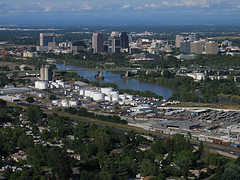 The new Draft Transportation 2035 Plan released Wednesday by the Bay Area’s Metropolitan Transportation Commission calls for $226 billion in spending over the next 25 years to “confront global warming and traffic congestion.” But close up, the plans seems more like a sorely needed band-aid to patch up the region’s ailing transit infrastructure. Fully 82% of the plan’s funding is designated for upgrading and maintaining the existing system, with 13% allotted for transit expansions.
The new Draft Transportation 2035 Plan released Wednesday by the Bay Area’s Metropolitan Transportation Commission calls for $226 billion in spending over the next 25 years to “confront global warming and traffic congestion.” But close up, the plans seems more like a sorely needed band-aid to patch up the region’s ailing transit infrastructure. Fully 82% of the plan’s funding is designated for upgrading and maintaining the existing system, with 13% allotted for transit expansions.
The plan includes $400 million (0.2%) for a “Transportation Climate Action Campaign” to raise public awareness about climate change and individual actions that residents can take to reduce the region’s carbon footprint. The campaign will also include a grants program to subsidize demonstration projects for reducing auto emissions with alternative fuels or car-sharing projects. An additional $1 billion is set aside for bicycle facilities and programs.
But when, by the MTC’s own numbers, 40% of the Bay Area’s emissions come from the transportation sector, $1.4 billion to fight greenhouse gas emissions seems paltry given that this is the plan to carry us through to 2035. By law, California’s greenhouse gas emissions need to be reduced approximately 30% by 2020.
MTC Executive Director Steve Heminger said the plan “tees up two strategies that we have consistently indentified as the most important in making progress in reducing environmental emissions like CO2, in reducing vehicle miles of travel, and those are road pricing, and a better link to land use without transportation investment.”
The idea is that reducing traffic congestion by increasing the cost of driving, be it with higher bridge tolls or charging drivers to use HOV lanes, greenhouse gas emissions will decrease. And by upgrading aspects of the region’s transit system, more people will choose to forgo the car and opt for public transit.
“From an infrastructure perspective, I think this plan is about as climate positive as it could be,” said Heminger.
Use the audio players to hear Heminger explain how the plan attacks climate change:
